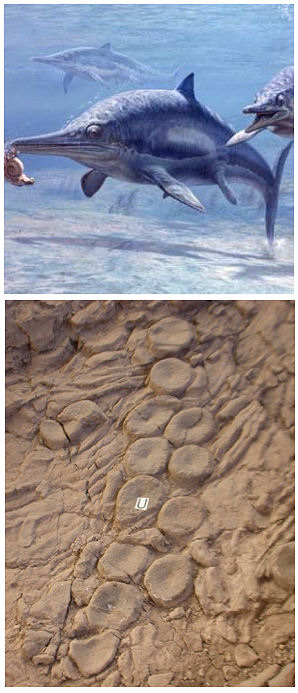11 October 2011
Artistic mega-octopus may topple ichthyosaur from top of Triassic food chain
by Kate Melville
 Neatly arranged fossilized vertebrae from a number of bus-sized ichthyosaurs could actually be a self portrait composed by a very large prehistoric octopus predator previously unknown to science, according to paleontologist Mark McMenamin, from Mount Holyoke College.
Neatly arranged fossilized vertebrae from a number of bus-sized ichthyosaurs could actually be a self portrait composed by a very large prehistoric octopus predator previously unknown to science, according to paleontologist Mark McMenamin, from Mount Holyoke College.
McMenamin's proposed rejig of the Triassic food chain places the air-breathing, snaggle-toothed ichthyosaur beneath what he says was an octopus of mythological proportions. McMenamin presented the results from his work at Berlin-Ichthyosaur State Park in Nevada yesterday at the annual meeting of the Geological Society of America in Minneapolis.
The Berlin-Ichthyosaur State Park is where the remains of nine neatly arranged 45-foot ichthyosaurs of the species Shonisaurus popularis are located. The fossils have a long history of perplexing researchers, including the foremost expert on the site: the late Charles Lewis Camp, of U.C. Berkeley. "Charles Camp puzzled over these fossils in the 1950s," said McMenamin. "In his papers he keeps referring to how peculiar this site is. We agree, it is peculiar."
Camp's interpretation was that the fossils probably represented death by an accidental stranding or from a toxic plankton bloom in shallow water. But more recent work on the rocks around the fossils suggests that it was a deep water environment, which makes the neatly arranged carcasses even more mysterious.
This question - shallow or deep ocean death - is what attracted McMenamin to the site. "I was aware that anytime there is controversy about depth, there is probably something interesting going on. It became very clear that something very odd was going on there," he explained. "It was a very odd configuration of bones."
He believes that the different degrees of etching on the bones suggest that the ichthyosaurs were not all killed and buried at the same time. Interestingly, it also appeared that the bones had been purposefully arranged. And it was this deliberate arranging of the bones that got him thinking about a particular modern predator that is known for just this sort of intelligent manipulation. "Modern octopus will do this," McMenamin notes. "What if there was an ancient, very large sort of octopus, like the kraken of mythology. I think that these things were captured by the kraken and taken to the midden and the cephalopod would take them apart."
In the fossil bed, some of the ichthyosaur vertebral disks are arranged in curious linear patterns with almost geometric regularity. The proposed Triassic kraken appears to have arranged the vertebral discs in double line patterns, with individual pieces nesting in a fitted fashion as if they were part of a puzzle. McMenamin suggests that the arranged vertebrae resemble the pattern of sucker discs on a cephalopod tentacle, with each vertebra strongly resembling a coleoid sucker. In other words, the vertebral disc "pavement" (pictured) seen at the state park may represent the earliest known self portrait.
McMenamin points out that there's modern evidence showing that octopi can easily prevail over other oceanic predators and he firmly believes that "this cephalopod in the Triassic was doing the same thing." He adds that there are many more ribs broken in the ichthyosaur fossils than would seem accidental and they have twisted necks. "It was either drowning them or breaking their necks," he suggests.
Unfortunately, McMenamin's theory may never be confirmed as octopi are mostly soft-bodied and don't fossilize well. Only their beaks are hard and the chances of those being preserved nearby are very low. That means the evidence for the giant Kraken is circumstantial, which may leave some scientists rather skeptical. But McMenamin isn't worried. "We're ready for this," he said. "We have a very good case."
Related:
Prehistoric "terror bird" jabbed prey like a boxer
T-rex a baby killer
Fifteen-Thousand-Foot Fossil Find Flummoxes Fossickers
Dino Detectives Decode Death Dance
Source: Geological Society of America
Pic courtesy Mark McMenamin
